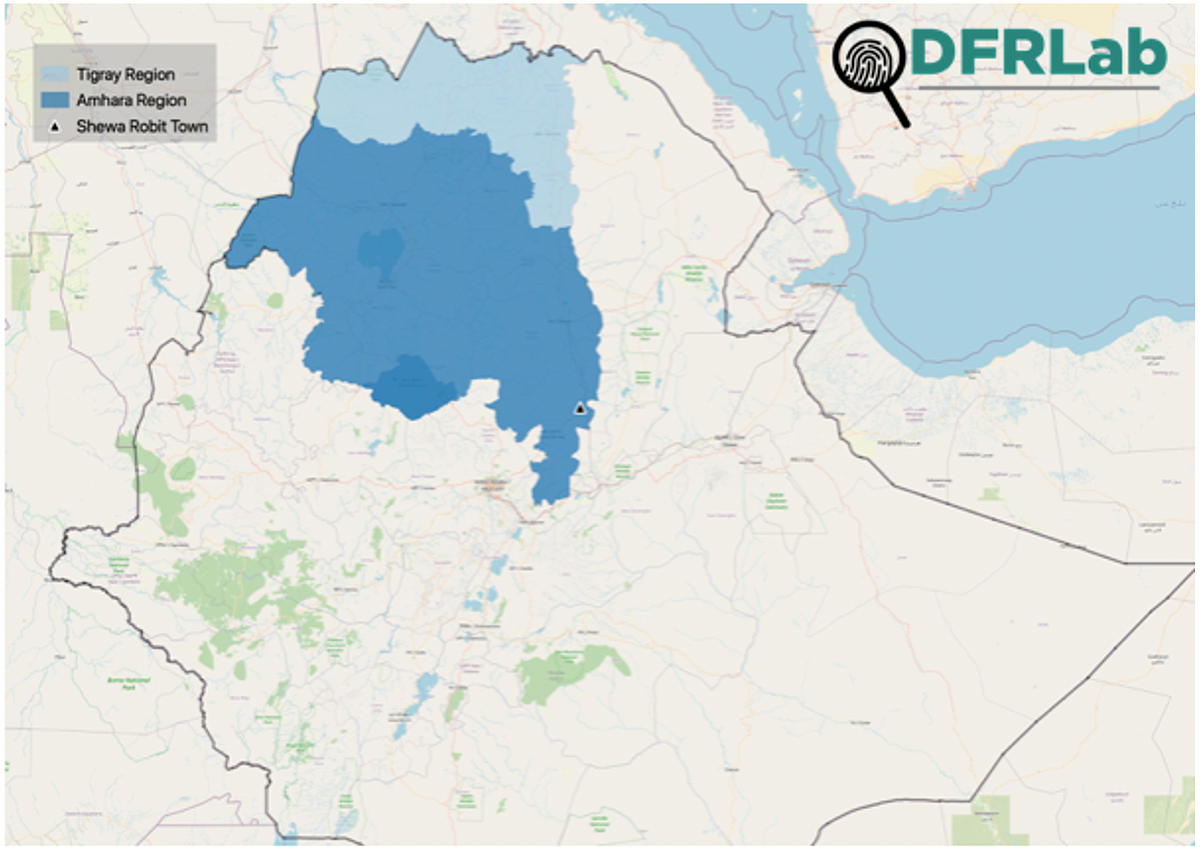Ethnic animosities in Amhara precipitated a brutal attack on an ambulance amid a humanitarian crisis in Ethiopia

By Adam Gates
Warning: this piece contains links to graphic imagery.
The DFRLab has geolocated footage of a brutal attack on an ambulance in the Amhara region of Ethiopia that started circulating on social media on April 5, 2021. This attack is one of many accounts of healthcare infrastructure, a key part of humanitarian access, being targeted to exert pressure on ethnic minority groups. Intentional attacks on medical personnel are a war crime that can be prosecuted at the International Criminal Court.
International focus on instability in Ethiopia and the wider Horn of Africa has primarily centered on the dire situation in the northernmost region of Tigray where approximately 85 percent of healthcare infrastructure has already been destroyed. The assessed video, however, is part of a distressing trend of broader ethnic violence targeting healthcare across the rest of the country.
Ethiopia’s 1994 constitution brokered a mandate to rule through balancing long simmering ethnic tensions by enshrining the government as a federated group of ethnic regions. Rising inter-ethnic conflict challenges that federation and threatens the cohesion of the government. The Ethiopian prime minister, Abiy Ahmed Ali, has sown distrust though months of denial that Eritrean forces were active in the Tigray region — a claim that was later walked back. As such, the prime minister’s promise that humanitarian access would be secured was met with skepticism.
The attack in Amhara assessed below presents further cause to doubt Abiy’s claims that humanitarian aid workers would be protected, as healthcare infrastructure has been targeted by various groups in the region. The attack presents further cause to doubt Abiy’s claims that humanitarian aid workers would be adequately protected, as healthcare infrastructure has been targeted by various groups in the region.
Similar attacks targeted healthcare services such as those provided by Médecins Sans Frontières, as well as hospitals that served vulnerable ethnic groups and provided desperately needed support to victims of gender-based violence, presents a worrying trend of violence against humanitarian and aid services.
Targeting healthcare infrastructure in this way indicates to internally displaced persons from minority ethnic groups that seeking healthcare is dangerous; this pressure has pushed them to make longer, more dangerous journeys to safety.
How the DFRLab geolocated the attack
The video showing the attack was originally spread on social media. On Twitter, the video circulated under the hashtag #ShawaRobitMassacre, which includes an alternate spelling of the Ethiopian town, Shewa Robit. The hashtag narrowed down the DFRLab’s search for the location of the attack to this town in the Amhara Region of Ethiopia.

Assessing open-source records of the region’s healthcare infrastructure allowed investigators to narrow down the possible destination of the ambulance. Then, image verification and geolocation techniques were used to verify the location as a Yefat primary hospital in Shewa Robit.
Stitched photography and imagery of the attack allowed investigators to reconstruct the location. As these tools provided more information, reference imagery was then consulted to further develop investigators’ understanding of the space. For example, in Figure 1, the DFRLab utilized image stitching to locate the curb where the attack occurred.

This greater understanding of the location meant that details from footage of the attack that were imperceptible in satellite imagery could then be identified in the reference footage. Figure 2 below illustrates how details in the stonework and coloration of the curb were rectified with reference imagery.

The area’s foliage provided another key set of datapoints to link the locations. Aside from their use as reference points, large-scale plant life such as hedges and trees also verified the locations’ boundaries. In this instance, the trees and hedges captured in Figure 3 outline the entrance of the hospital grounds.


Combining these methods of investigation allowed for a compelling verification of attack’s location to Yefat Primary Hospital in Shewa Robit.
A trap set at a local hospital
In the video, an Amharic-speaking mob is shown beating eight passengers within the ambulance to death. The ambulance was transporting patients who were Oromo — a regional ethnic minority — and translation of the speech in the assessed videos indicates the ambulance and the patients it was carrying were targeted for this reason. Eyewitness accounts also asserted that some members of the mob wore the uniform of the Ethiopian federal police and others wore the fatigues of the Amhara regional forces.

The involvement of such groups in these attacks indicates that government forces could have participated in actions that obstruct humanitarian access. Continued lack of access inhibits action to address compounding issues of famine, the COVID-19 pandemic, and rising numbers of internally displaced persons.
The self-perpetuating nature of ethnic violence and the targeting of healthcare infrastructure, coupled with the government’s inability to ensure unimpeded humanitarian access, sets the stage for sustained insecurity in Ethiopia.
Adam Gates is a research intern with the Digital Forensic Research Lab.
Translations provided by DFRLab partner Code for Africa’s PesaCheck fact-checkers based in Ethiopia.
Cite this case study:
Adam Gates, “Violent attack in Ethiopia targets healthcare access,” Digital Forensic Research Lab (DFRLab), May 3, 2021, https://medium.com/dfrlab/violent-attack-in-ethiopia-targets-healthcare-access-285d27706ce4.
Follow along for more in-depth analysis from our #DigitalSherlocks.

